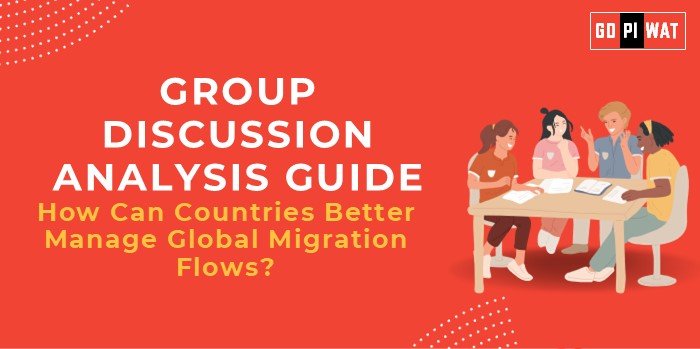📋 Group Discussion (GD) Analysis Guide
🌟 How Can Countries Better Manage Global Migration Flows?
🌐 Introduction to the Topic
Opening Context: Global migration has become a defining phenomenon of the 21st century, impacting economies, societies, and geopolitics. As of 2023, over 281 million people worldwide live outside their birth country, driven by economic opportunities, conflicts, and climate change.
Topic Background: Migration management is a complex interplay of policies balancing humanitarian needs and national interests. The challenges range from ensuring human rights to maintaining national security and economic stability.
📊 Quick Facts and Key Statistics
- 🌍 Global Migrants (2023): 281 million, or 3.6% of the global population, highlighting migration’s growing impact.
- 🧑🤝🧑 Refugees Worldwide: 35.3 million under UNHCR’s mandate, a record high.
- 💵 Remittances in 2022: $647 billion sent to low- and middle-income countries, underscoring migration’s economic significance.
- 🌊 Climate Displacement: 23.7 million displaced annually due to climate-related disasters.
👥 Stakeholders and Their Roles
- 🇺🇳 Governments: Enact immigration laws, secure borders, and ensure societal integration.
- 🌐 International Organizations: UNHCR and IOM provide support and frameworks for managing migration crises.
- 🏢 Private Sector: Addresses labor shortages and supports skill-based migration.
- 🤝 Civil Society: Advocates for migrants’ rights and integration into host communities.
🏆 Achievements and Challenges
- 🎯 Achievements:
- Economic Benefits: Remittances contribute significantly to home countries’ GDP (e.g., Nepal 23.5%).
- Policy Innovations: Canada’s point-based immigration system is a model for balancing skills and demographic needs.
- Refugee Integration: Germany’s programs successfully integrated over 1.2 million refugees since 2015.
- ⚠️ Challenges:
- Irregular Migration: Smuggling networks thrive, endangering lives and violating borders.
- Integration Hurdles: Cultural and economic integration issues persist in host countries.
- Climate Migration: Policies to address displacement due to rising sea levels remain underdeveloped.
🌍 Global Comparisons
- 🇦🇺 Australia: Effectively manages skilled migration but faces criticism over offshore detention centers.
- 🇧🇩 Bangladesh: Struggles to provide resources for 1 million Rohingya refugees.
Case Studies:
- EU Migration Pact: Aims to balance burden-sharing and solidarity but faces political resistance.
📋 Structured Arguments for Discussion
- ✔️ Supporting Stance: “Countries benefit immensely from well-managed migration flows, as seen in increased GDP contributions and cultural enrichment.”
- ❌ Opposing Stance: “Unregulated migration strains public resources, stokes societal tensions, and challenges national security.”
- ⚖️ Balanced Perspective: “While migration fosters economic growth and innovation, it must be managed with policies ensuring security and integration.”
🛠️ Effective Discussion Approaches
- 🔍 Opening Approaches:
- Highlighting statistics on economic contributions of migrants.
- Discussing humanitarian obligations through global examples like Syria.
- 💬 Counter-Argument Handling:
- Rebuttal: “While security concerns are valid, comprehensive vetting processes reduce risks significantly.”
- Example: Germany’s success in integrating Syrian refugees through education and job training.
📈 Strategic Analysis of Strengths and Weaknesses
- 🟢 Strengths: Cultural diversity, economic growth, global solidarity.
- 🟡 Weaknesses: Security risks, strain on infrastructure, political resistance.
- 🔵 Opportunities: Skill-based migration policies, climate-resilient planning, tech-enabled integration.
- 🔴 Threats: Xenophobia, geopolitical conflicts, climate change.
📚 Connecting with B-School Applications
- 🌏 Real-World Applications:
- Policies on migration impact global finance, supply chains, and demographics—key B-school project themes.
- 🤔 Sample Interview Questions:
- “How can businesses leverage migration to address skill shortages?”
- “Evaluate the role of public-private partnerships in migration management.”
- 💡 Insights for Students:
- Migration intersects with policy, economics, and innovation—a versatile topic for internships and research.


